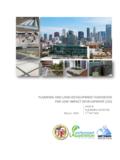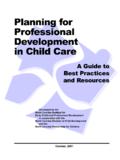Transcription of Product Planning And Development Process
1 Product Planning And Development Process Hans Hjort Hans Hjort Consulting Copyright 2001, Hans Hjort Consulting. Typical Product Development Review structure Opportunity On-going Commercialization Management Reviews Technical Design Reviews VOC Defined VOC Approach proposed Gate 1 Performance Requirements defined Product Concept proposed TDR I Gate 2 Product Design completed Process Concept proposed TDR II Process Design Completed Gate 3 Verification and Validation Prototypes built Test Plan proposed TDR III Product Released and Launched Gate 4 Ship to Volume Post Launch Review User Needs Design Planning
2 Design Input Design Output Design Verification & Validation Design Transfer Typical Phases MK M0 M1 3 Customers Job 5 Job 3 Job 1 Job 2 Job 4 Job n Business Vision/Mission PP TP Innovation Process Potential Technologies Potential solutions Solutions Bookshelf 1. 1. 2. 3. 4. Product and technology Planning 5. 5. Product and Technology Planning 4 Customers Job 5 Job 3 Job 1 Job 2 Job 4 Job n Jobs can be: Clinical Operational Social Economic Etc. Job 5 Job 3 Marketing takes the lead on identifying jobs and collecting data (imp.)
3 & sat.) from customers Business/Marketing are involved in selecting attractive jobs for plannedt effort. Business Case/Project Charter Attractive jobs could be new outcomes, jobs that we do not currently address, jobs that are important but nobody has been able to satisfy well, or jobs where we have a distinct competitive disadvantage Early Marketing and Clinical Roles Define Seminal Idea Copyright 2001, Hans Hjort Consulting. Opportunity Space (US, Europe, and Japan) IC (Lap & Open) CC (Lap & Open) Laparoscopic JejunoJejunostomy Laparoscopic Gastrojejunostomy Park BAR Sutures Staples CR (Lap & Open) Customer Groups Technologies Customer Jobs Glue Initial Focus Next Potentials Open JejunoJejunostomy Open Gastrojejunostomy (Surgeons) 1 2 3 4 5 Endoluminal Surgery 6 Copyright 2001, Hans Hjort Consulting.
4 System Subsystem Component Process Process Map Customers Input Validation Copyright 2002, Hans Hjort Consulting. Customers Business Case/Project Charter Basic Expectations System Requirements 80/20 Non-Critical Parameters To Satisfy The Performance Parameters. V O C Techn. Targets A B C Concept Evaluation Best Concept Regulatory requirements Critical Parameters Market Strategy Internal Standards Copyright 2001, Hans Hjort Consulting. VOC Needs & Wants Performance Parameters Relative importance/satisfaction of needs System Targets Alternative Concepts Internal Business Criteria Selected System Level Concept(s) Sub-systems Sub-system 1 Etc.
5 Plan Evaluate / Select Deploy Plan Sub-system 2 Sub-system n Prioritize Sub-systems Product Planning Copyright 2001, Hans Hjort Consulting. Customer Needs (VOC) System Parameters Most significant Parameters to satisfy the needs Market Strategy Technical Strategy (parameters targets) System Planning Matrix (VOC Based) Significant System Parameters and Targets (requirements) System level Planning matrix Vital few (CTQs) to support market strategy System Name:SDS100/SDSD01 Owner:Date:5/29/2003 Product Level Requirement CTQO wnerLowerUpperNUDL imitNominalLimitMeanStd.
6 Capability MethodMeanStd. Capability MethodMeanStd. Capability MethodMeasurement System AnalysisLevel of AutomationThe system will automatically detect when respiratory rate is "0" for 30 sec. of the of Monitoring SystemRespiratory RateY3 bpmEtCO2 AccuracyY12%# of User Interaction steps/time19/20 of the trained users shall change infusion rate within 3 sec. while at seconds19/20 of trained users shall be capable of a total procedure setup time (up to drug start) <45 <45 secondsEnd case turn-around: 19/20 of trained users shall be capable of the following interaction times: Total procedure removal time < 45 sec.
7 , Total recovery removal time <1 min.,(< min when patient connected to entire system at once)"Y<45 secondsSedation Delivery SystemProduct Code:Target ValueDesign PredictionDesign Verification Process Validation DataScorecard Voice of Customer (VOC) Customers Start with long list of customer issues (mix of needs and features from different sources) Customer interviews and observations I need the patient to receive the exact prescription that was ordered by the doctor. For example: I need the pump to be able to be programmed automatically from the pharmacy system Not how it may be accomplished: What is a VOC ?
8 Not to be included in the VOC list: Givens (or basic expectations) Regulations and standards VOB (Voice of Business) Then rephrase, eliminate, transfer issues to result in manageable list (10-25) The list of VOCs defines our opportunity for competitive advantage Copyright 2001, Hans Hjort Consulting. 79 customer issues (mix of needs and features from different sources 25 customer needs (VOC) 6 CVOC Opportunity Space Market strategy (Spider Chart) 2 3 5 1 4 Team members know what to accomplish for customers and why Market Strategy Copyright 2001, Hans Hjort Consulting.)
9 Needs vs. Customer Satisfaction (Kano) Very Satisfied Customers Very Dissatisfied Customers Did not Address Customer Need at all Fully Supplied Customer Need Articulated Needs Latent Needs Basic Expectations Voice of Customer (VOC) What do we need to know about the VOC ? Importance: Is this issue (VOC) important enough to the customer to be recognized if satisfied better by us than our competitors? Satisfaction: How well does the customer feel our current Product satisfies each VOC? How well does the customer feel ours and our competitors products satisfies each VOC?
10 By collecting these perceptions from the customers we are able to understand the landscape that we are trying to influence to achieve the results identified in the project charter Product Requirement What converts a VOC to a Product requirement? Desired/Future Satisfaction: Knowing the current situation surrounding the VOCs, the Development team assigns the satisfaction profile that must be achieved to gain the desired competitive position The desired satisfaction profile is based on the team s assessment about current state of technologies as well as the Product /company image that must be reinforced.






